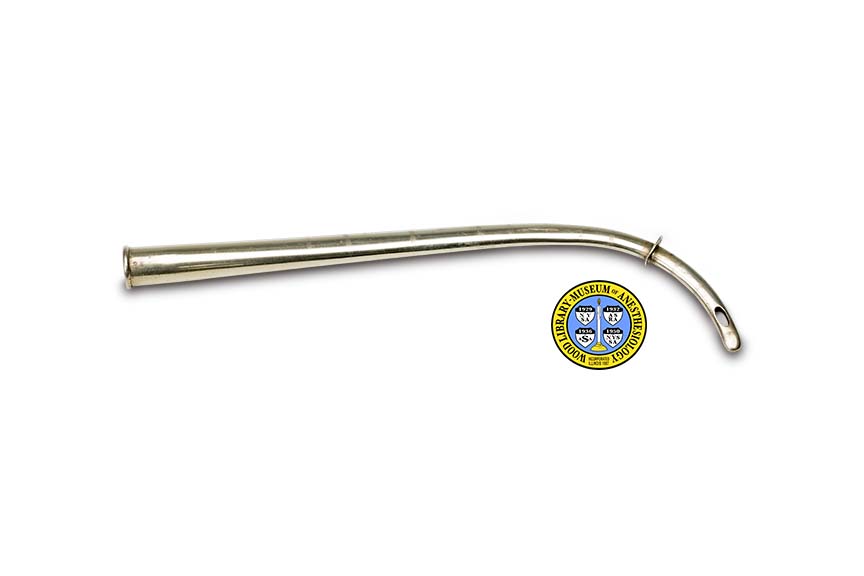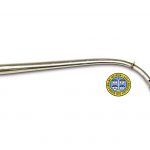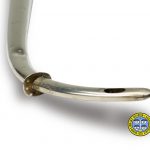Chaussier Laryngeal Tube
This curved metal tube was introduced in 1806 by French anatomist and obstetrician François Chaussier (1746-1828) for the resuscitation of newborn infants. At the time Chaussier was a professor at the École Polytechnique and chief obstetrician at the Maternité de Paris.
To insert the tube, the physician would first use his or her little finger to reach into the infant’s mouth and beyond the tongue to find the opening to the lungs. The laryngeal end of the tube was then slid along the little finger and inserted into the infant’s larynx. The larynx, which contains the vocal cords, is part of the respiratory tract and is the entrance to the trachea (windpipe). The physician would administer artificial respirations by using his lips or a small bellows to blow air through the tube and into the infant’s lungs.
So that air would not escape around the tube, Chaussier included a kind of seal in the tube’s design. A few centimeters from the laryngeal end, a small metal disk is welded around the tube. The disk is perforated with a few small holes so that a piece of soft sponge, agaric, or buffalo skin could be sewn to it. Once the tube was in place, the disk and sponge helped to block the escape of air during artificial respirations.
Years earlier, in 1781, after inventing a machine to produce oxygen and using it to revive newborn infants, Chaussier became the first physician to report administering oxygen to newborns.
Catalog Record: Chaussier Laryngeal Tube
Access Key: altz
Accession No.: 2014-12-03-1
Title: [Sonde du larynx, or, Tube laryngien] / [M. Chaussier.]
Author: Chaussier, François, 1746-1828.
Title variation: Alt Title
Title: Chaussier neonatal resuscitation tube.
Title variation: Alt Title
Title: Tube laryngien de Chaussier.
Title variation: Alt Title
Title: Chaussier’s laryngeal tube.
Title variation: Alt Title
Title: Chaussier laryngeal tube.
Publisher: [Place of production not indicated] : [Name of producer not indicated],
[between 1806 and 1880?]
Physical Descript 1 airway : silver ; 4 cm x 1.5 x 15.5 cm.
Note Type: General
Notes: The early year in the date range for the possible year of manufacture of this
example is based on the year that Dr. Chaussier first described his airway,
1806. The end date is an estimate based on the latest instrument maker
catalog in which Chaussier’s tube was found (Mathieu, 1867). The date range
could change if documentation that indicates the dates should be corrected is
discovered.
Note Type: General
Notes: The title is based on the words used by Dr. Chaussier in describing his
airway.
Note Type: Citation
Notes: Le discours de François Chaussier en 1806 in : Archives de l’Assistance
publique de Paris. Liasse 678. F.O.S.S. : Procès-verbaux des Distributions
des Prix, faites aux Elèves sagesfemmes de la Maternité, in 8°, 1805-1824.
[This citation was used to request copies of Dr. Chaussier’s lecture from the
Archives de l’AP-HP. The name of the tube was taken from page 29. This
citation came from the article by Henri Stofft, titled, “La mort apparente du
nouveau-né en 1781 et en 1806. L’oeuvre de François Chaussier.” Another
author (Obladen, 2009) who has cited Dr. Chaussier’s 1806 lecture, provides a
slightly different citation: “Chaussier F: Procès verbaux de distribution de
prix, faites aux élèves-sages-femmes de la la Maternité, 1805-1824. Vol.
Cote 678, FOSS 1, Liasse 678. Paris, Archives de l’Assistance Publique de
Paris, 1806, pp 54-113.”]
Note Type: Citation
Notes: François Chaussier (1746-1828). Sabix: Société des amis de la Bibliothèque et
de l’Histoire de l’École Polytechnique website. https://www.sabix.
org/documents/chaussier.html. Accessed April 20, 2015.
Note Type: Citation
Notes: Maison Charrière: Robert & Collin Successeurs Fournisseurs de la Maison de
l’Empereur. Paris: Chez Robert et Collin; 1867:33. https://books.google.
com/books?id=c5gm8cmwvdMC&printsec=frontcover#v=onepage&q&f=false. Accessed
April 21, 2015.
Note Type: Citation
Notes: L. Mathieu Fabricant d’Instruments de Chirurgie. Hollande: Maison a La Haye;
1867:15. https://catalog.hathitrust.org/Record/009344226. Accessed April 21,
2015. [“34. Tube laryngien de Chaussier, en argent.” under “Accouchements” at
bottom of right column.]
Note Type: Citation
Notes: Obladen M. History of neonatal resuscitation – part 2: oxygen and other drugs
Neonatology. 2009;95(1):91-96.
Note Type: Citation
Notes: Obladen M. History of neonatal resuscitation – part 3: endotracheal
intubation. Neonatology. 2009;95(3):198-202.
Note Type: Citation
Notes: Stofft H. La mort apparente du nouveau-né en 1781 et en 1806. L’oeuvre de
François Chaussier. Hist Sci Med. 1997;31(3-4):341-349
Note Type: Physical Description
Notes: One curved, metal tube; It appears to be made of silver; The silver is mildly
to moderately tarnished, and there are a number of scuff marks; There are
also three dents in the tube, two are more obvious that the third; The
measurements, and this description, are based on a patient’s perspective, i.e
the laryngeal end is the proximal end; Without rounding the tube measures
approximately 4 cm x 1.1 x 15.6 cm (height x width x depth); The width was
taken at the widest point (the distal end); The proximal end of the tube is
rounded; Approximately 1 cm from the proximal end, two oval shaped eyelets
perforate each side of the tube; The eyelets each measure approximately .3 x
6 cm; Approximately 3.7 cm from the proximal end a transverse disc, or washer
is welded around the exterior of the tube; Three small holes perforate one
side of the disc; There are no maker markings.
Note Type: Reproduction
Notes: Photographed for the WLM by Mr. Steve Donisch, January 12, 2015.
Note Type: Historical
Notes: This curved metal tube was introduced in 1806 by French anatomist and obstetrician François Chaussier (1746-1828) for the resuscitation of newborn infants. At the time Chaussier was a professor at the École Polytechnique and chief obstetrician at the Maternité de Paris.
To insert the tube, the physician would first use his or her little finger to reach into the infant’s mouth and beyond the tongue to find the opening to the lungs. The laryngeal end of the tube was then slid along the little finger and inserted into the infant’s larynx. The larynx, which contains the vocal cords, is part of the respiratory tract and is the entrance to the trachea (windpipe). The physician would administer artificial respirations by using his lips or a small bellows to blow air through the tube and into the infant’s lungs.
So that air would not escape around the tube, Chaussier included a kind of seal in the tube’s design. A few centimeters from the laryngeal end, a small metal disk is welded around the tube. The disk is perforated with a few small holes so that a piece of soft sponge, agaric, or buffalo skin could be sewn to it. Once the tube was in place, the disk and sponge helped to block the escape of air during artificial respirations.
Years earlier, in 1781, after inventing a machine to produce oxygen and using it to revive newborn infants, Chaussier became the first physician to report administering oxygen to newborns.
Note Type: Exhibition
Notes: Selected for the WLM website (noted March 26, 2015).




